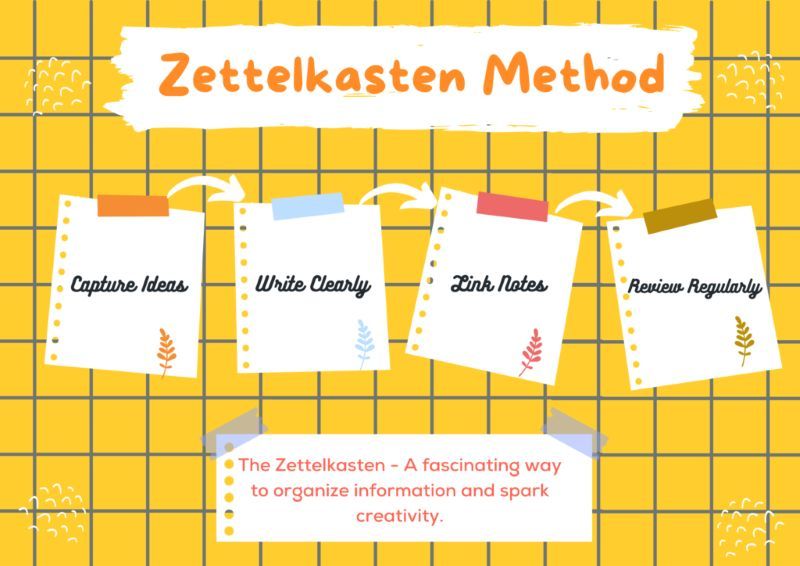

The Zettelkasten method is a powerful note-taking system that can revolutionize how you organize and process information. Let's learn more about this topic below with Iron Snout, exploring how to implement this technique effectively.
The Zettelkasten method, developed by German sociologist Niklas Luhmann, is a unique approach to note-taking and knowledge management. It involves creating interconnected notes that form a network of ideas. This system allows for easy retrieval and synthesis of information, making it ideal for researchers, writers, and lifelong learners.
At its core, the Zettelkasten method is about creating atomic notes - small, self-contained units of information. Each note captures a single idea or concept, making it easier to connect and combine ideas later. This approach encourages critical thinking and helps users develop a more nuanced understanding of complex topics.
The power of the Zettelkasten method lies in its flexibility and scalability. As you add more notes to your system, the network of connections grows, allowing for unexpected insights and discoveries. This organic growth of knowledge is what makes the Zettelkasten method so effective for long-term learning and creativity.
To start using the Zettelkasten method, you'll need to set up a system that works for you. While Luhmann used physical index cards, modern practitioners often opt for digital tools. Regardless of the medium you choose, the principles remain the same.
First, choose a tool that allows for easy creation and linking of notes. Many digital note-taking apps now support this functionality, making it easier than ever to implement the Zettelkasten method. Look for features like internal linking, tagging, and full-text search to enhance your note-taking experience.
Next, establish a consistent format for your notes. Each note should have a unique identifier, a title, and the main content. You may also want to include metadata such as tags, creation date, and links to related notes. This structure will help you organize and retrieve information more efficiently.
Consider creating an index or entry point for your Zettelkasten. This can be a note that lists broad topics or areas of interest, with links to relevant notes. As your system grows, this index will help you navigate your network of ideas more easily.
When creating notes for your Zettelkasten, focus on capturing ideas in your own words. Avoid simply copying and pasting information. Instead, process and rephrase the content to ensure you understand it fully. This active engagement with the material will enhance your learning and retention.
Keep your notes concise and focused on a single idea or concept. If you find yourself writing about multiple related topics, consider breaking the note into smaller, more specific notes. This granularity will make it easier to link ideas and discover connections later.
Use clear and descriptive titles for your notes. This will help you quickly identify the content of each note when browsing or searching your Zettelkasten. Avoid vague or generic titles that might become confusing as your system grows.
The true power of the Zettelkasten method lies in the connections between notes. As you create new notes, actively look for opportunities to link them to existing ones. These links can be based on shared concepts, themes, or any other relevant association.
Consider using bidirectional links when connecting notes. This means that if note A links to note B, note B should also link back to note A. This two-way connection helps create a more robust network of ideas and makes it easier to explore related concepts.
Tags can be a useful tool for organizing your notes, but use them judiciously. Avoid creating too many tags, as this can lead to overwhelm and make it harder to find relevant information. Instead, focus on a core set of tags that reflect your main areas of interest or study.
Regularly review and maintain your Zettelkasten. As you add new notes, you may discover opportunities to refine or reorganize existing ones. This ongoing curation process helps keep your system relevant and useful over time.
Once you've built up a substantial collection of notes, you can start leveraging your Zettelkasten for deeper learning and creative projects. Use your network of notes to explore ideas from different angles and discover unexpected connections between concepts.
When starting a new project or tackling a complex problem, turn to your Zettelkasten for inspiration. Browse through related notes and follow the links to see where they lead. This process can help spark new ideas and provide fresh perspectives on familiar topics.
Use your Zettelkasten as a brainstorming tool. When faced with a challenge, create a new note about the problem and start linking it to relevant existing notes. This can help you identify potential solutions or approaches you might not have considered otherwise.
As you become more comfortable with the basic Zettelkasten method, you can explore advanced techniques to further enhance your note-taking and knowledge management. These strategies can help you extract even more value from your system.
One advanced technique is the creation of structure notes. These are notes that provide an overview or outline of a particular topic, linking to more detailed notes on specific aspects. Structure notes can help you organize complex subjects and see the big picture more clearly.
Another useful technique is the development of concept notes. These are notes that explore abstract ideas or principles that apply across multiple domains. By linking concept notes to more concrete examples, you can develop a deeper understanding of how these ideas manifest in different contexts.
Consider implementing a regular review process for your Zettelkasten. Set aside time each week or month to browse through your notes, looking for new connections or insights. This deliberate exploration can lead to unexpected discoveries and help you identify gaps in your knowledge.
The Zettelkasten method can be complementary to other productivity systems and workflows. For example, you can use it alongside project management tools to capture and organize ideas related to specific projects or goals.
Consider how your Zettelkasten can support your daily work or study routine. You might use it to prepare for meetings, brainstorm solutions to problems, or develop outlines for writing projects. The key is to make your Zettelkasten an integral part of your workflow, rather than a separate activity.
Experiment with different ways of visualizing your Zettelkasten network. Some digital tools offer graph views that can help you see connections between notes more clearly. These visual representations can reveal patterns and clusters of ideas that might not be apparent through text alone.
As with any system, you may encounter challenges when implementing the Zettelkasten method. Being aware of these potential pitfalls can help you navigate them more effectively and maintain a productive note-taking practice.
One common challenge is the temptation to create too many notes or links. While it's important to capture ideas, avoid cluttering your system with unnecessary information. Focus on quality over quantity, and be selective about what you include in your Zettelkasten.
Another challenge is maintaining consistency in your note-taking habits. It's easy to fall out of the habit of creating and linking notes regularly. To overcome this, consider integrating Zettelkasten into your daily routine, perhaps by setting aside dedicated time for note-taking and review.
Some users struggle with deciding how to organize their notes or when to create new ones. Remember that the Zettelkasten method is flexible and personal. Trust your instincts and experiment with different approaches until you find what works best for you.
Your Zettelkasten should evolve as your knowledge and interests grow. Don't be afraid to refine your system over time, adjusting your note-taking practices and organizational strategies as needed. This flexibility is one of the strengths of the Zettelkasten method.
As your collection of notes grows, you may need to revisit and update older notes. This process of revision can help reinforce your understanding of the material and ensure that your Zettelkasten remains relevant and useful.
Consider sharing insights from your Zettelkasten with others. This could be through writing, presentations, or discussions. Articulating your ideas to others can help solidify your understanding and potentially lead to new insights or collaborations.
The Zettelkasten method is a powerful tool for lifelong learning and intellectual growth. By consistently applying these principles and techniques, you can create a personal knowledge management system that supports your goals and enhances your cognitive capabilities. Remember that mastering the Zettelkasten method is a journey, and each note you create is a step towards greater understanding and creativity.